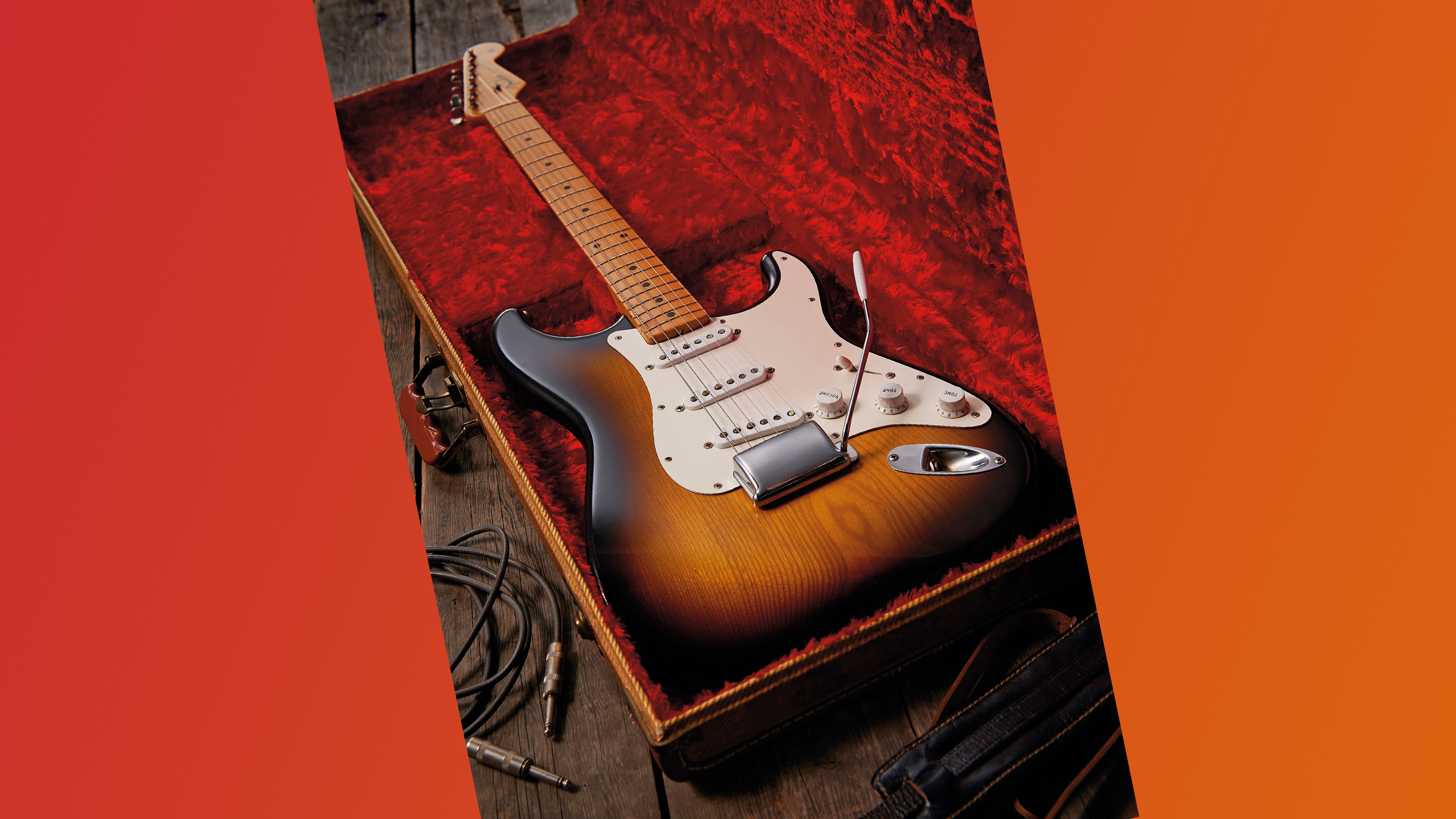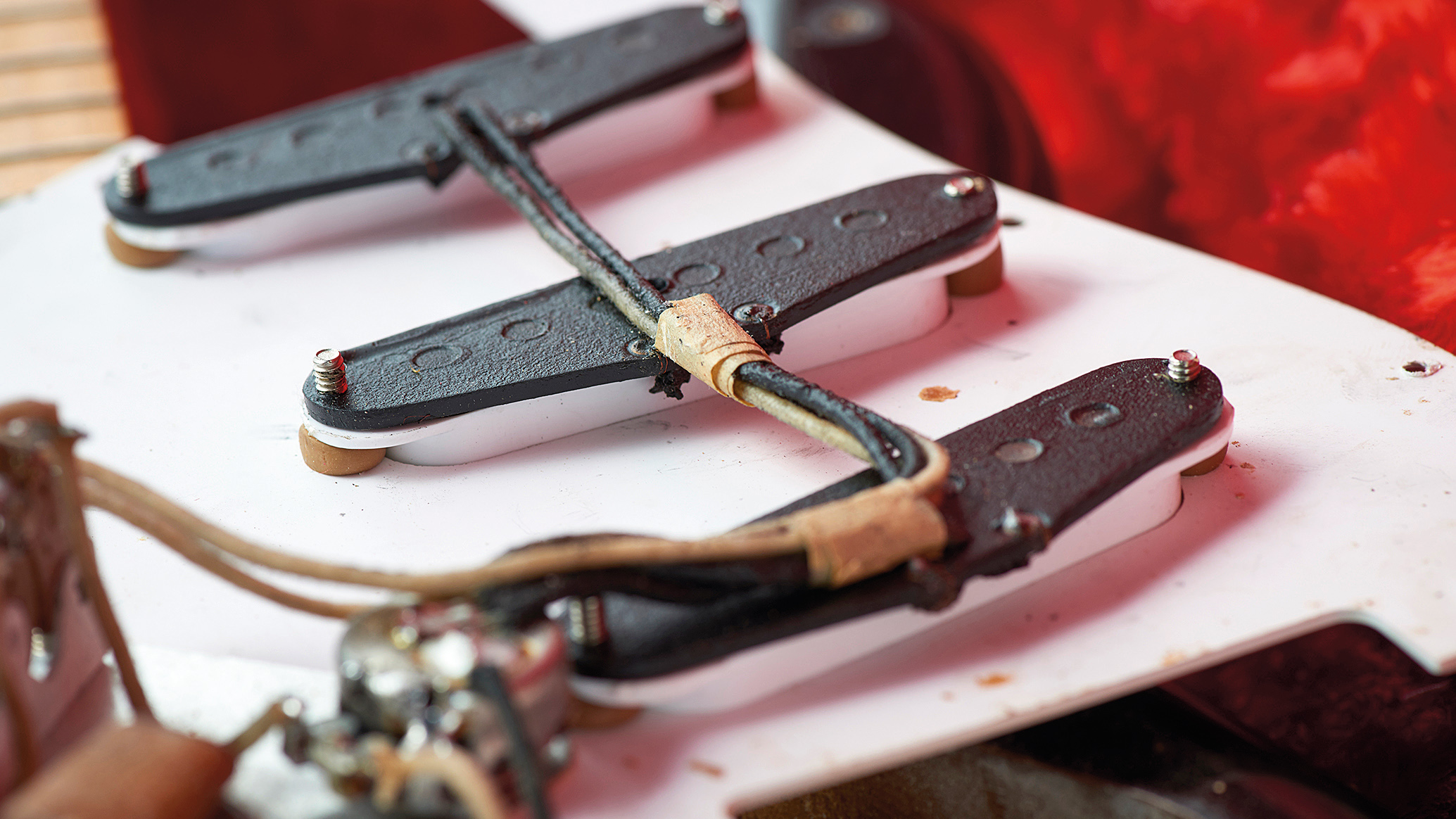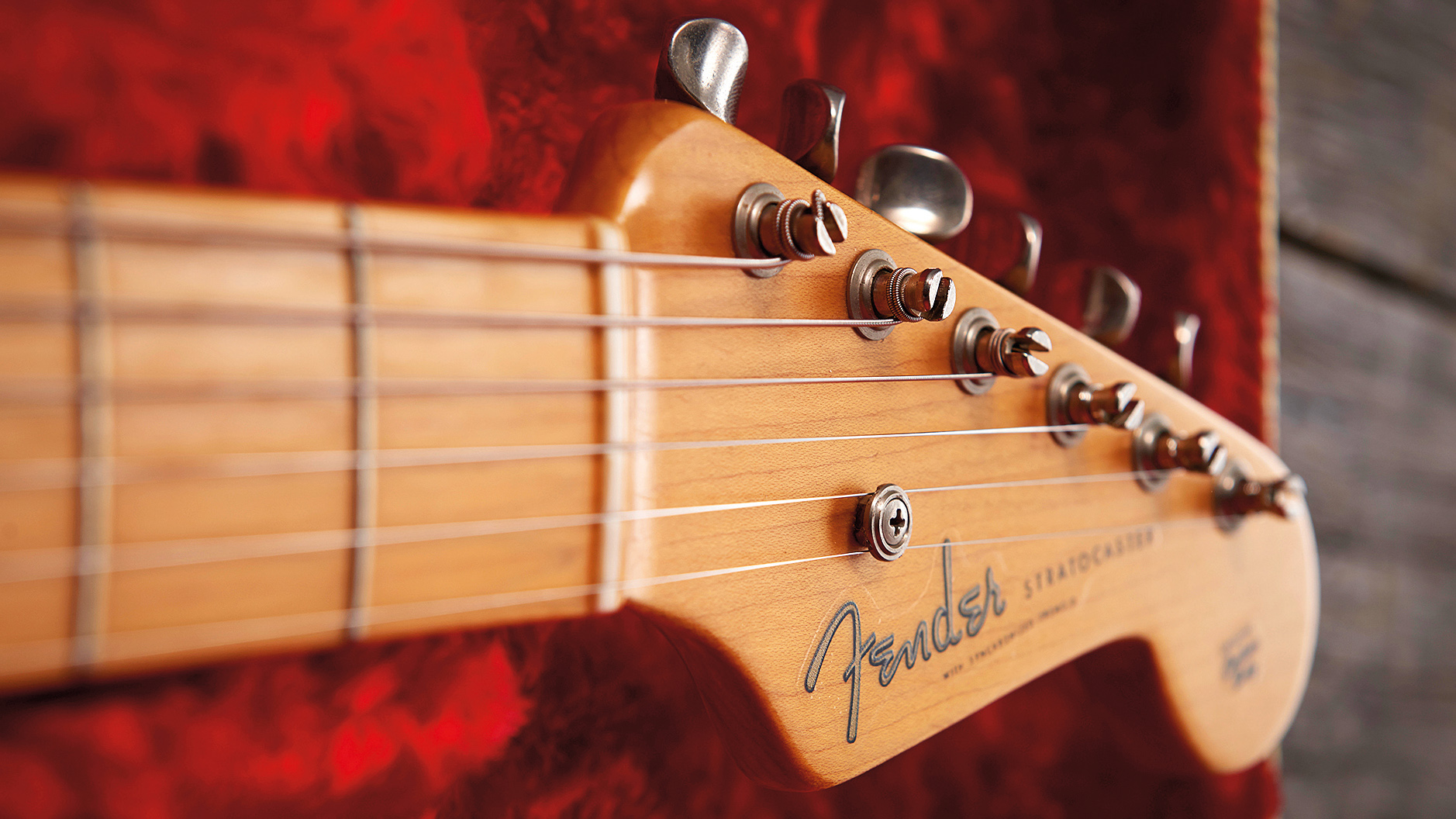Under the microscope: Fender 1954 Stratocaster
Pristine original in pictures

Origin of the species
Some guitars, such as Fender’s Strat, become so familiar over time that they attract accolades such as ‘timeless’ and ‘iconic’ like a magnet attracts paperclips.
Yet look closely at an original 1954 Stratocaster and you realise how different it is to the Strats of today. So, we put a pristine original example under the microscope to uncover the intriguing spec details that set the earliest Strats apart from their latter-day descendants…
Icon
Now here’s a curious thing. From Buddy Holly to Mark Knopfler, so many celebrated guitarists have used Strats over the years that the sleek, twin-horned outline of the Strat is as familiar as the back of your hand.
With a little trepidation, we took up our screwdriverto peer under the hood
In fact, if you asked a child to draw an electric guitar there’s a high chance they’d draw something that resembled one, right down to the trio of pickups with one mounted at angle at the bridge.
But take a really close look at a variety of Strats built over the six decades that they’ve been manufactured and you start to realise that the Strat’s iconic body shape, as well as more obvious spec changes, has drifted quite a bit from its original form over time.
Indeed, it’s only when you get up close to an original ’54 Strat that you realise how much those apparently changeless contours have changed between the 50s and the present day. For example, mid-50s Strat bodies have a svelte kind of greyhound slimness, while as you edge into the CBS era they appear to become a little stockier and more purposeful-looking.
Those differences are not illusory but reflect small but significant changes in the way the guitars were made – and each change tells a story about the way guitars used to be made, compared to how they are now.
So when Rod Brakes, proprietor of Vintage & Rare Guitars in Bath, showed us a very clean ’54 Strat in near-complete original condition, we took it as a cue to chart some of the subtle and not-so-subtle ways in which this most familiar of all electric guitars has evolved since the earliest examples appeared.
With a little trepidation, we took up our screwdriverto peer under the hood of this elegant first-year-of-production example.
“What we have here is a Stratocaster built in July 1954,” Rod explains as we begin our examination. “It’s perfectly original aside from a few extra screw holes that have been made in the scratchplate here at some point and a non-original cover over the vibrato cavity.
"There’s a little bit of superficial fret-wear. But by and large, this has been kept in its case for the majority of its life. The finish has not faded at all. It still looks really rich and lush, as it was when it left the factory,” he adds.
“They started making Strats in earnest from October 1954, although there were early models made from March on. This is number 522.” Until autumn of ’54, Strats were almost prototypes rather than full production models with a stable spec.
“During this early period of Stratocaster production, the dates on the body and the neck tended to match up very closely, often to within six months and sometimes within the same month. This one is actually marked ‘TG July ’54’, which indicates that Tadeo Gomez [celebrated Fender neck shaper] made it July ’54.
"The body is also marked as being made in July ’54,” Rodsays of the hand-pencilled date on the neck, a hallmark of early Fender production, except in 1959 when the system was briefly suspended after an employee supposedly left some obscene remarks on one guitar’s neck. Neck dating marks were later stamped in ink from ’62 on.
Although the prices commanded by rare vintage guitars have stabilised somewhat in recent years, the most sought-after vintage Fenders and Gibsons are still worth a lot of money in pristine, original condition.
Thanks to their bolt-on necks, old Fenders are especially susceptible to becoming ‘bitsa’ guitars over the years, as parts are chopped and changed by various owners, with the guitar losing some of its cachet, from a collector’s point of view, in the process.
So very careful examination of construction details needs to be made before one can be sure that a guitar remains in the original state in which it left Fullerton. Some of these clues can be gleaned from the finish.
“Often the finish hadn’t really dried completely before the neck and body were assembled: sometimes, it was still a little bit tacky. So often some of that finish will get stuck to the neckplate during assembly: you should see a mirror-image almost, like a fingerprint, on the plate.
"You’ll also see those kind of matching imprints on the neck pocket and the neck itself,” Rod explains. Other clues come from residues found beneath seldom removed parts, such as the bridge, he adds. “On this guitar, there was finishing fluid, this reddish-tinted stuff Fender used to finish the guitars and some of that was still visible just under the bridge, under the trim here.”
Dangerous Curves
But not all of the signifiers of a ’54 build are so subtle. One of the most striking features of very early Strats are the graceful and gently rounded contours of the body, which indicate the amount of skilled hand-work that went into shaping in the era before the degree of mechanisation increased.
The belly carve, for example, is much longer than on later mid-60s Strats: less of a scallop shape and more of a graceful, sweeping curve. The subtle radius on the edges of the headstock, and where it graduates into the neck, is also noticeably softer and more gently sculpted than on later post-’55 Strats, like an ice-lolly that’s melted just a bit.
“Back then their production methods were significantly different from what we have nowadays,” Rod continues. “It was like a workshop and there was more hands-on craftsmanship involved. You’ll see that in things like the edges of the headstock, which are nicely rolled off.
"That only lasted a little while. I suppose when things ramped up, they become a little squarer. It was obviously time-consuming to do that degree of hand-finishing, so in time it disappeared. But it’s really beautiful.”
However, although some of the details of the early Strats were a bit more ‘bespoke’ than the more workmanlike models that followed in the 60s, many of the components were later upgraded to more durable alternatives, as it gradually became clear that the relatively primitive plastics used on pickup covers and other parts wasn’t durable enough.
“They didn’t get it all right to begin with,” Rod argues. “Some of the original spec details were slightly flawed. To begin with, the pickup covers were made of polystyrene, sometimes [erroneously] termed Bakelite. It’s pretty fragile and it looks different from the tougher ABS parts that followed: it’s a lot whiter and more translucent and marble-y looking.
“But these early parts are very, very fragile, especially over time. If a guitar has been played even a moderate amount you would expect to see cracks in those delicate materials.”
The precise dimensions of familiar parts such as the volume and tone knobs are slightly different from the modern Fender norm, too.
“They’re just slightly different dimensions, but very recognisable. The selector switch is also a rounder type of switch tip, often known as a ‘football switch’. It looks like an American football I guess. But perhaps surprisingly the three-way pickup selector itself was actually kept by Fender until the late 70s.”
Turn the guitar over, and a closer examination of the vibrato block reveals more subtle differences when comparedto later Strats.
“It’s easy to see that on the trem block, the holes are drilled not so deep: the ball-end of the string is virtually at the surface of the block. Later on, they were recessed much deeper. They’re often milled much more round as well on the edges there. It’s a painted steel block. You can distinguish it fairly easily from later blocks.”
A Question Of Heritage
Viewed as a whole, the guitar is remarkably clean – so much so that fear of scuffing its glowing finish hangs over you a bit while you play, although as we found when we plugged it into a ‘brownface’ Fender Princeton, this Strat is harmonically rich and vibrant, while the bridge pickup is almost as ballsy and trebly as a good Tele’s.
Is it wrong to feel a little intimidated by such ‘time machine’ guitars? Should we find it sad rather than attractive that it is in such obviously unplayed condition? Or, at this stage in the game, is it in fact beneficial that a few near-perfect examples are preserved carefully for posterity rather than played to bits?
It’s a tough call. After all, while hardly common, there are tatty but great-sounding ’54 Strats around that can show us what a great early Fender sounds like. Ultimately, only the owner of the individual instrument can decide what fate such instruments deserve: pristine timepiece or working tool.
“It would be cool to preserve this guitar for future generations, I think,” Rod offers after some thought. “I like guitars to be played as much as the next person, but I think sometimes you get certain [very clean] vintage guitars and… they’ve gone over the edge of something: it’s arguably come too far to take them down the Dog & Duck and start playing in your band or whatever.
"These things are very, very rare. It’s just really cool to see. I don’t know what will happen to it in the end.”
Jamie Dickson is Editor-in-Chief of Guitarist magazine, Britain's best-selling and longest-running monthly for guitar players. He started his career at the Daily Telegraph in London, where his first assignment was interviewing blue-eyed soul legend Robert Palmer, going on to become a full-time author on music, writing for benchmark references such as 1001 Albums You Must Hear Before You Die and Dorling Kindersley's How To Play Guitar Step By Step. He joined Guitarist in 2011 and since then it has been his privilege to interview everyone from B.B. King to St. Vincent for Guitarist's readers, while sharing insights into scores of historic guitars, from Rory Gallagher's '61 Strat to the first Martin D-28 ever made.













